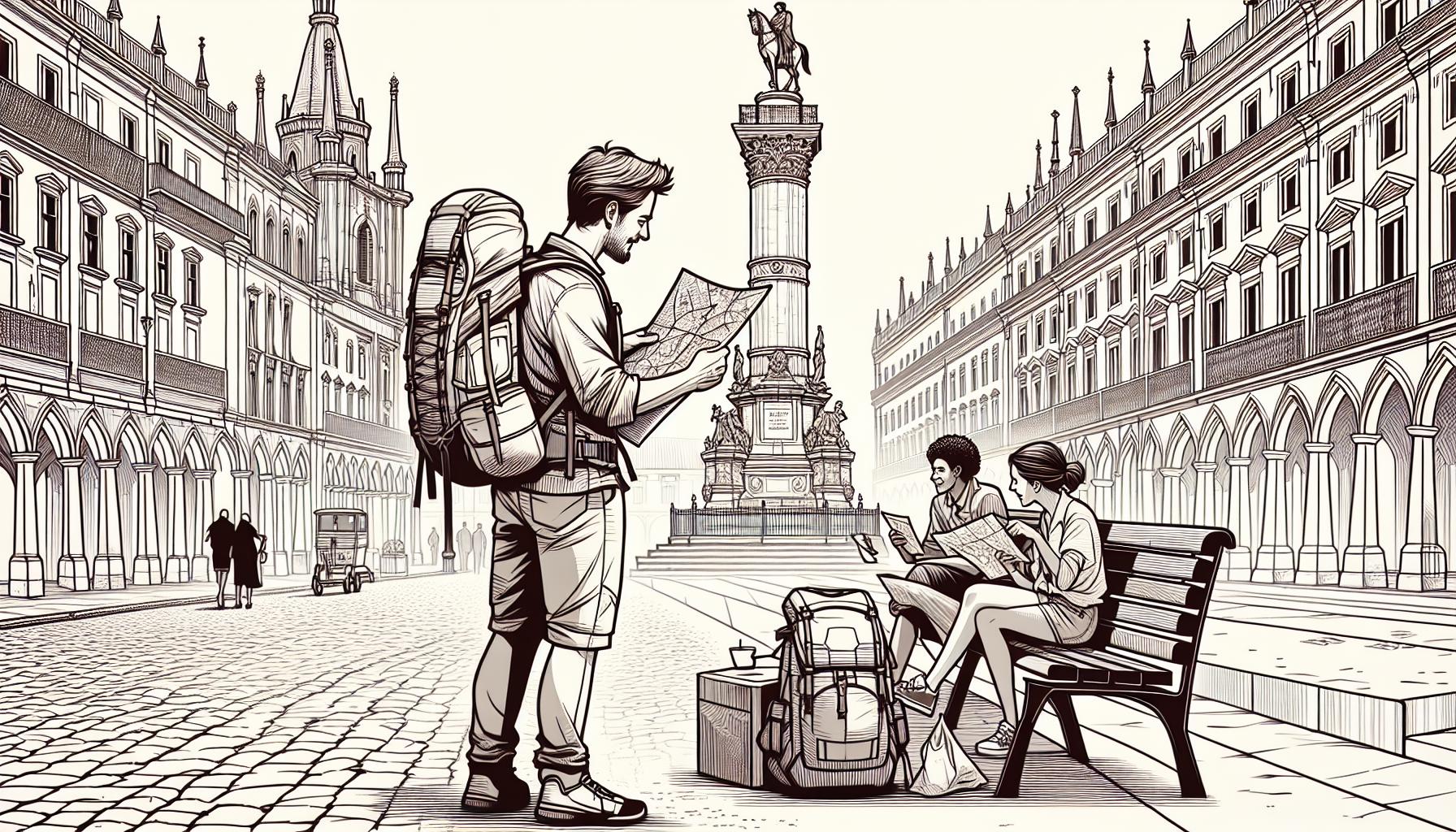Planning a year-long sojourn across Europe? The cost of traveling Europe for a year can vary greatly, depending on one’s travel style, destinations chosen, and the time of year.
From budget backpackers to luxury seekers, everyone’s got a different price tag. It’s essential to understand the potential costs involved in such an extended trip. This article will provide a realistic estimate of what one can expect to spend during a year of European exploration.
Remember, it’s not just about the flights and accommodation. There’s also the cost of meals, local transportation, sightseeing, and those unexpected expenses that can sneak up on even the most seasoned traveler. Let’s take a deep jump into the cost of a year-long European adventure.
Factors Affecting the Cost of Traveling in Europe
With Europe’s diverse range of cultures, cuisines, and landscapes, various factors come into play when calculating the cost of a year-long journey. Below are some primary determinants.
Transportation
Transportation is a major factor affecting travel costs. Europe offers various transportation options such as flights, buses, trains, and car rentals. Frequent travelers could consider a Eurail Pass, an all-in-one ticket to unlimited travel across Europe’s extensive rail network in 33 countries.
Airlines like Ryanair and EasyJet offer budget-friendly flights but remember to account for extra fees, such as baggage charges or priority boarding. The prices can vary depending on the season and specific destination cities.
Accommodation
Accommodation prices can vary extensively based on style and comfort level. High-end resorts in popular tourist destinations can be comparatively expensive.
Budget accommodations like hostels are a great option for solo travelers or backpackers. Apartments or vacation rentals offer a cost-effective option for extended stays. Booking platforms such as Airbnb and Booking.com offer choices across a wide spectrum.
Food and Drinks
The cost of food and drinks in Europe can add up quickly, especially when dining out frequently. While some countries like Italy and Spain might offer exceptional value for money, others like Switzerland and Norway are notoriously expensive. Hence, mix in some budget-friendly local street food or try cooking in hostel kitchens to balance out costs.
Activities and Attractions
Europe is packed with an array of attractions, from historic landmarks like the Colosseum in Rome or the Eiffel Tower in Paris to natural wonders like the Swiss Alps. Remember, entry fees for these attractions can significantly impact the budget. Sightseeing passes can, more often than not, offer value if your itinerary includes many tourist spots.
Exchange Rates
Tourists traveling from countries with a strong currency might find their money stretches further. Be aware of fluctuating exchange rates and consider securing some currency in advance if a favorable rate is available. Currency exchange services like TransferWise or Revolut can often provide better rates than traditional banks.
Bear in mind that these factors represent the broad cost bases encountered when planning a trip through Europe. The actual costs incurred will fluctuate depending on the specific circumstances of each journey.
Creating a Budget for Traveling in Europe

Creating a reasonable budget for a yearlong adventure in Europe need not be a challenging job. With the right information, the appropriate adjustments, and a keen eye on expenditure, one could smoothly sail through the year, economically speaking.
Researching Average Costs
The first step towards designing a foolproof budget is to research average costs. It’s crucial to have a rough idea of how much life will cost in Europe. This includes not only essentials like accommodation, food, and transport but also entertainment, yields, and unforeseen expenses.
Data on average daily costs in European countries can be found online. These statistics offer a guide on costs to expect in different countries.
Costs of Various European Countries (USD Per Day)
| Accommodation | Food | Transportation | Entertainment | |
|---|---|---|---|---|
| Spain | 55 | 35 | 36 | 27 |
| France | 74 | 49 | 39 | 35 |
| Germany | 66 | 41 | 38 | 31 |
| Greece | 50 | 35 | 32 | 26 |
Costs include budget options
Bear in mind, these are average costs, one’s individual costs may be lower or higher depending on spending habits and preferences.
Setting Priorities and Making Trade-Offs
Next, it’s all about Setting Priorities and Making Trade-Offs. Everyone has their non-negotiables when it comes to traveling. For some, it’s a comfortable bed to sleep in every night. For others, it’s eating locally prepared food at every meal.
Knowing what’s vital can help one allocate accordingly. If food is the most important consideration, then allocate more funds to food and less on activities. To maintain the budget balance, lowering expenditure in one area means increasing in another area.
Tools to Help with Budgeting
To keep track of all these considerations, there are various budgeting tools available. Tools like Trail Wallet or Mint allow users to input their daily spending and visualize where they’re going over their budget.
Tracking and Managing Expenses
The key to successful budgeting when traveling Europe for a year is Tracking and Managing Expenses. This is where one ensures they’re sticking to the plan. If spending tends to run high in certain areas, it might be necessary to readjust the budget or spending habits to ensure everything remains manageable.
Travel smartly by understanding cards that offer better exchange rates or ones that don’t charge foreign transaction fees. By keeping an eye on these variables – researching, setting priorities, tracking expenses – one can keep the costs of traveling Europe for a year within a reasonable budget. All set for an adventure of a lifetime.
Saving Money while Traveling in Europe

Traveling doesn’t always mean very costly. With careful planning and savvy tactics, travelers can save quite a bit even while globetrotting across the old continent. Let’s explore some strategies to do just that.
Traveling in the Off-Season
Tourist demand peaks during summer and winter holidays when popular destinations can often see their prices skyrocket. Traveling in the off-season, which usually coincides with spring and autumn, brings multiple benefits.
- Lower prices for accommodation and flights are almost guaranteed.
- Attractions are less crowded, providing a better experience.
- There’s less hustle and bustle, offering a more authentic local vibe.
Travelers should keep in mind that the off-peak season might vary in different regions of Europe.
Booking in Advance
Airlines and hotels want to secure as many bookings as early as possible. That’s why they often offer lower prices months ahead.
- Early birds get the worm, and also excellent discounts and deals.
- Remember to be flexible with travel dates to find the best bargains.
- Online tools and websites come in handy while comparing prices and hunting for deals.
Utilizing Public Transportation
Rail, bus, ferry, urban transport – Europe is famous for its well-linked public transportation networks.
- It’s cheaper than taxis or rental cars.
- It’s a great way to interact with locals and experience their everyday life.
- Daily, weekly, or tourist passes offer unlimited travel at a minimal cost.
Cooking Meals and Eating Local
European cuisine is diverse and delicious, but dining out every day can exhaust travel budgets quickly.
- Cooking meals can significantly cut down the food bills.
- Local markets offer fresh, reasonably priced ingredients.
- When eating out, consider local haunts instead of tourist-trap restaurants for a more affordable yet authentic taste.
Taking Advantage of Free Activities and Attractions
Europe is steeped in history, culture, and timeless beauty, much of which doesn’t cost a dime.
- Parks, markets, festivals, and churches are often free to explore.
- Many museums and attractions have certain days or hours with free admission.
- Self-guided walks or hikes reveal the true charm of a place without lightening the wallet.
Remember to approach budgeting as a delicate balance between spending and experiencing. It’s not about seeing everything at the lowest price but about experiencing the most authentic and rewarding aspects of European travel within a budget that doesn’t bleed you dry.
Tips for Sticking to Your Travel Budget

While setting a budget for a long-term trip can be relatively straightforward, sticking to it always requires conscious effort and consistent planning. Here are some strategies that’ll inform wiser spending decisions and help stretch those travel dollars further.
Managing Daily Expenses
When traveling to Europe for an extended period, everyday expenses can quickly add up. Eating out less frequently and shopping at local markets for groceries not only saves money, it’s also a fantastic way to immerse oneself in local culture. The key here is establishing a daily budget for food, transportation, and other necessities, and sticking to it. Being mindful of these expenses can lead to a fuller and more affordable travel experience.
Controlling Impulse Purchases
Souvenirs can quickly drain a travel budget, so it’s important to control impulse purchases. Whilst a memento from the trip can be nice, a hundred mementos can blow a budget. Instead, look for unique, cost-effective keepsakes. Remember, the best souvenirs are often free: photographs, for instance, can be beautiful reminders of your journey.
Using Cash Wisely
When traveling, it’s tempting to rely solely on credit cards for convenience, but this can lead to overspending. Drawing a certain amount of cash each week and leaving the cards for emergencies helps keep spending in check. This cash-only policy forces the traveler to physically see their money decreasing, which in turn can lead to more thoughtful expenditure.
Bargaining and Negotiating
In markets and local stores, it’s worth trying to bargain. Vendors are often open to negotiation, especially towards the end of the day. Just be respectful in your haggling—you don’t want to offend by offering too low a price.
Sharing Expenses with Travel Partners
Traveling with a friend or a group can significantly cut costs. This way, some expenses can be split, like accommodation and transportation costs. Shared meals can also be more cost-effective. But, be sure everyone agrees on the expense-sharing rules at the beginning of the trip to avoid misunderstandings down the line.
As you can see, there are many ways to control spending while traveling and, so, stick to a budget. It does require a level of discipline and foresight, but with these tips in mind, you’ll find yourself able to stretch your travel budget and perhaps even extend your stay in Europe, all while enjoying a rich and rewarding travel experience.
Traveling to Europe for a year doesn’t have to be expensive. It’s all about smart planning and finding ways to save.
Remember, it’s not just about pinching pennies but also about balancing your spending with unforgettable experiences.
Yes, managing daily expenses and keeping impulse buys in check is crucial. But don’t forget to treat yourself occasionally and immerse yourself in the local culture. Sharing costs with travel buddies can also lighten the financial load.
Eventually, it’s about making your European adventure as rewarding as possible without overspending. So, pack your bags, plan wisely, and get ready for an incredible, budget-friendly year in Europe!
